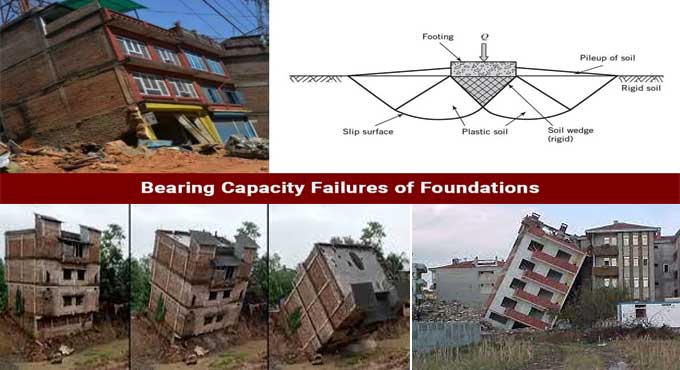
Understanding Types of Bearing Capacity Failures in Soil: Crucial Insights for Construction
In the vast landscape of construction engineering, the stability and safety of structures hinge significantly upon the bearing capacity of the underlying soil. Bearing capacity, a pivotal parameter delineates how much load the soil can support without succumbing to detrimental deformation or failure. Recognizing the types of bearing capacity failures in the soil is imperative for engineers and builders, ensuring the longevity and resilience of structures.
Importance of Bearing Capacity in Construction
Bearing capacity is a fundamental consideration in the design and construction of any structure, be it a residential building, a bridge, or a skyscraper. The ability of soil to support loads directly influences the safety, stability, and overall performance of a construction project. Insufficient bearing capacity can lead to settlements, tilting, or even collapse of structures, causing severe consequences in terms of safety, economic losses, and potential environmental impact.
Several factors contribute to the significance of bearing capacity in construction:
Structural Integrity
The primary purpose of bearing capacity analysis is to ensure the structural integrity of a building or infrastructure. Properly understanding the soil's capacity to bear loads is crucial for designing foundations that can distribute the weight effectively and prevent excessive settlement.
Safety of Occupants
Inadequate bearing capacity poses a direct threat to the safety of occupants. If the soil beneath a structure fails to support the load, it can result in structural damage, compromising the safety of those living or working in the building.
Economic Considerations
The cost of construction is significantly influenced by the type of foundation required. A thorough analysis of bearing capacity helps optimize foundation design, reducing unnecessary expenses while ensuring the longevity and stability of the structure.
Environmental Impact
Bearing capacity failures can have environmental repercussions. Collapsed structures may lead to soil erosion, contamination, and other environmental issues, affecting the surrounding ecosystem.
Types of Bearing Capacity Failures
Understanding the different types of bearing capacity failures is crucial for engineers to implement effective solutions. There are several types of failures that occur most commonly:
General Shear Failure
General shear failure occurs when the entire foundation soil layer fails simultaneously. This failure mode is characterized by a well-defined shear plane, typically at a 45-degree angle. It often happens in cohesive soils and is associated with a sudden, catastrophic collapse of the foundation.
Local Shear Failure
Local shear failure is more localized than general shear failure, involving the failure of only a portion of the foundation soil. This type of failure is often observed in non-cohesive soils and can result in tilting or differential settlement of the structure.
Punching Shear Failure
Punching shear failure is common in footings, where the applied load causes a concentrated failure in the soil beneath the foundation. A cylindrical or conical-shaped failure zone beneath the footing characterizes this failure mode.
Settlement Failure
Settlement failure occurs when the soil undergoes excessive compression, leading to overall subsidence of the structure. This type of failure is typically associated with fine-grained soils and can result in a gradual sinking of the entire structure.
Uplift Failure
Uplift failure occurs when the foundation experiences upward forces, causing the structure to lift. This is common in areas with high groundwater tables or in situations where the structure is subject to buoyancy forces.
Fixes for Bearing Capacity Failures
Addressing bearing capacity failures requires a systematic approach that takes into account the specific conditions of the site and the type of failure observed. Here are some common fixes for different types of bearing capacity failures:
Improving Soil Bearing Capacity:
- Soil Stabilization: The use of soil stabilization techniques, such as chemical additives or geogrid reinforcements, can enhance the bearing capacity of the soil.
- Compaction: Adequate compaction of the soil during the construction phase can increase its density and, consequently, its bearing capacity.
Foundation Redesign:
- Increased Footing Size: Enlarging the size of the foundation footing distributes the load over a larger area, reducing the pressure on the soil and mitigating the risk of failure.
- Pile Foundations: In areas with weak or compressible soils, pile foundations can transfer the load to deeper, more stable layers, preventing settlement.
Drainage Improvement:
- Subsurface Drainage: Proper subsurface drainage can reduce the risk of bearing capacity failures by controlling water content in the soil, preventing excessive saturation and promoting soil stability.
Load Redistribution:
- Balancing Loads: Redistributing loads within a structure can help minimize differential settlements and prevent local shear failures. This may involve adjusting the placement of heavy equipment or modifying the structure's layout.
Uplift Prevention:
- Waterproofing: Installing effective waterproofing measures can prevent water from infiltrating the foundation soil, reducing the likelihood of uplift failure.
- Counterweights: In situations where buoyancy forces are a concern, adding counterweights or ballast can counteract uplift forces and stabilize the structure.
Conclusion
Bearing capacity failures in soil pose significant challenges to the construction industry, impacting the safety, stability, and economic viability of structures. A comprehensive understanding of the types of failures and the implementation of appropriate fixes are essential for ensuring the success of construction projects.
To get more details, watch the following video tutorial.
Video Source: Professor of Civil
Engineers and builders must conduct thorough site investigations, soil analyses, and bearing capacity assessments to tailor their designs to the specific conditions of the site. By incorporating effective fixes, such as soil stabilization, foundation redesign, drainage improvement, load redistribution, and uplift prevention measures, construction professionals can mitigate the risks associated with bearing capacity failures, creating structures that stand the test of time and contribute to a safer and more sustainable built environment.


